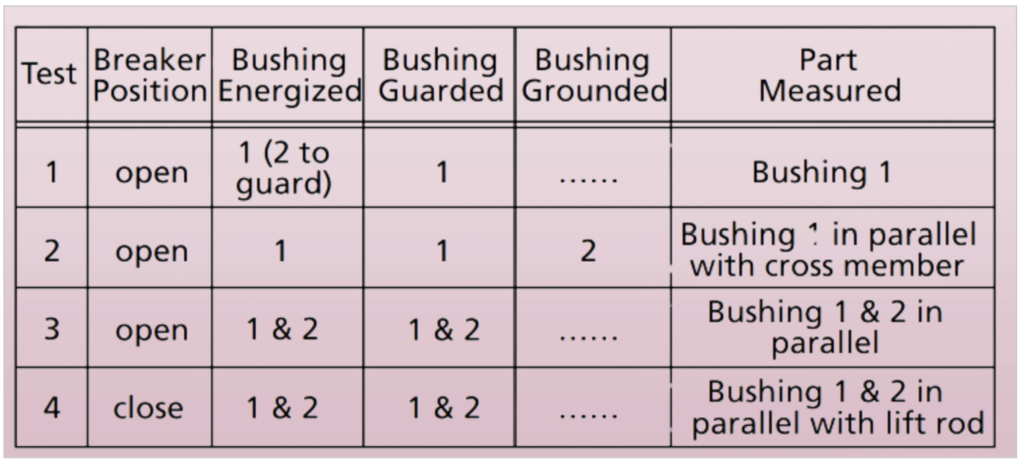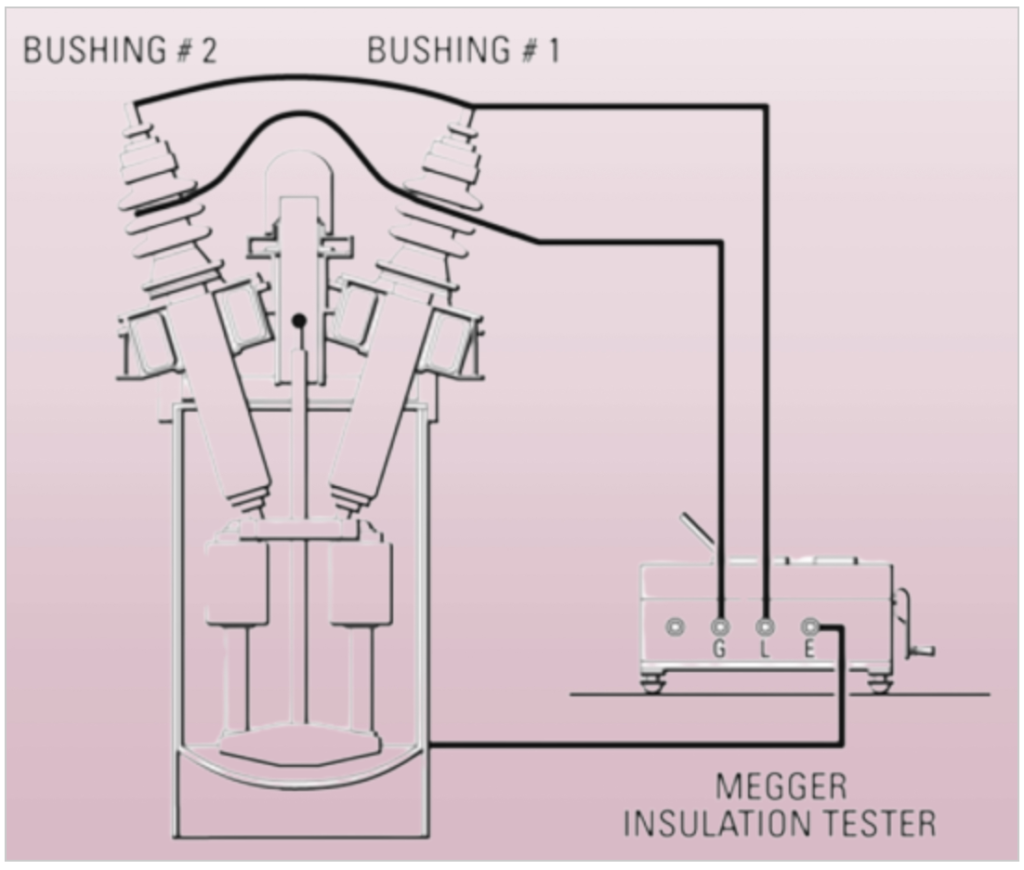Outdoor Oil Circuit Breaker Bushing Testing Procedure
The testing procedure for outdoor oil circuit breaker bushings and associated parts involves a series of steps, as indicated in the accompanying table. Here, we provide an overview of these steps and their significance in assessing the condition of the equipment:
Test Breaker Position: Before conducting the tests, it’s essential to ensure that the circuit breaker is in the correct position, whether open or closed, depending on the specific test being performed.
Bushing Energized: In each step, a specific bushing is energized to assess its insulation resistance.
Bushing Guarded: The guarding of a bushing refers to providing additional protection or isolation to prevent leakage currents from affecting the test results.
Bushing Grounded: In some steps, bushings are grounded to simulate their typical operating conditions.
Parts Measured: The table specifies which parts of the equipment are being measured in each step.

Test Procedure Steps:
- Step 1: Open Circuit Breaker, Bushing 1 Energized
- Purpose: To test the insulation resistance of bushing 1 when the circuit breaker is open.
- Bushing Configuration: Bushing 1 is energized.

- Step 2: Open Circuit Breaker, Bushing 1 Guarded 1
- Purpose: To assess the insulation resistance of bushing 1 when guarded, preventing leakage currents.
- Bushing Configuration: Bushing 1 is guarded.

- Step 3: Open Circuit Breaker, Bushing 1 and 2 Grounded (1 & 2)
- Purpose: To test the insulation resistance of bushings 1 and 2 when both are grounded.
- Bushing Configuration: Bushings 1 and 2 are grounded.

- Step 4: Close Circuit Breaker, Bushing 1 & 2 Energized, Bushing Guarded (1 & 2)
- Purpose: To assess the insulation resistance of both bushings when the circuit breaker is closed.
- Bushing Configuration: Bushings 1 and 2 are energized.

The testing procedure is repeated for other configurations and bushings as necessary. The results of these tests are crucial for evaluating the condition of the bushings and identifying any issues with their insulation resistance.
Interpreting Test Results:
- Insulation Resistance Values: The main parameter being measured in each step is the insulation resistance. Test values below 10,000 megohms indicate potential issues with the insulation.
- Guarding: Guarding specific bushings can help isolate them from external factors that may affect the test results. This technique is used to evaluate the bushings’ insulation properties under different conditions.
- Grounding: Grounding certain bushings simulates their typical operating conditions and helps assess their insulation resistance in a realistic context.
Action Based on Test Values:
- If any test values fall below 10,000 megohms, it is recommended to lower or drain the tank to isolate excessive losses. Further tests and investigations are necessary to identify and address the insulation issues.
- In test #1, if the initial insulation resistance value is below 50,000 megohms, more frequent tests should be conducted to monitor the condition of the involved bushing.
In summary, the testing procedures for outdoor oil circuit breakers and their bushings are essential for ensuring the equipment’s integrity and reliability. Regular testing, close monitoring of insulation resistance values, and appropriate actions based on test results are key elements of effective maintenance and safety practices in electrical systems.
Related Articles:
What is Good insulation?
What Makes Insulation Go Bad?
How Insulation Resistance is Measured.
How to Interpret Resistance Readings.
Factors Affecting Insulation Resistance Readings.
Types of Insulation Resistance Tests.
Test Voltage vs. Equipment Rating.
AC Testing vs. DC.
Use of DC Dielectric Test Set.
Tests During Drying out of Equipment.
Effect of Temperature on insulation Resistance.
Effects of humidity.
Preparation of Apparatus to test.
Safety Precautions.
Connections for testing insulation resistance of electrical equipment.
Additional Notes About using A Megger Insulation Tester.
Interpretation-Minimum Values.
Minimum Values for Insulation Resistance.
Tests Using Multi-Voltage Megger Insulation Testers.
Step-Voltage Method.
Use of a Guard Terminal.